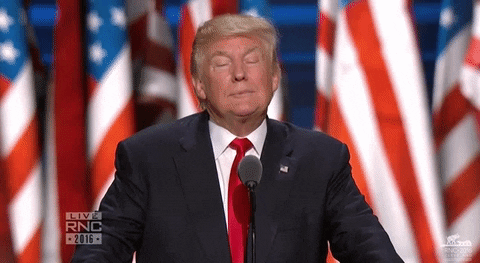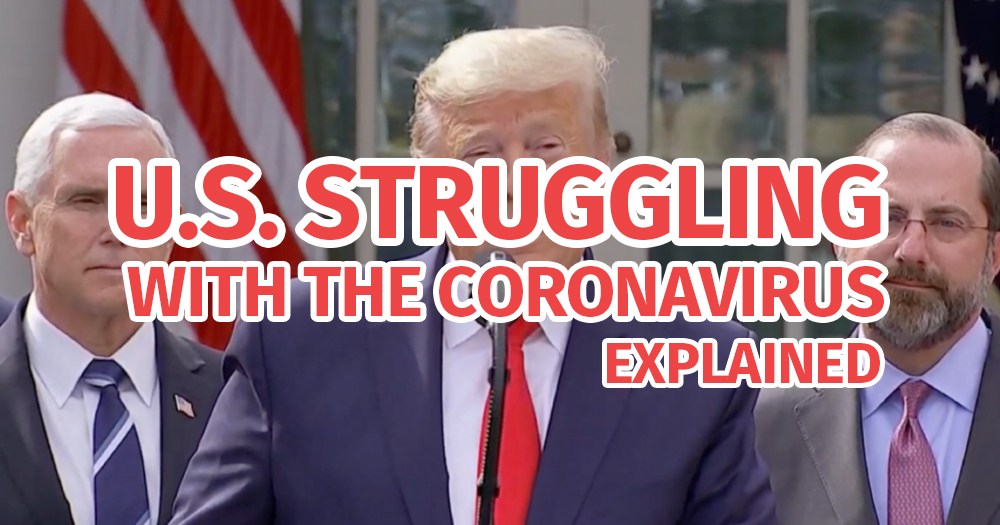It's Mar. 16 and if you haven't already heard, the coronavirus is tearing the U.S. a new one.
To see a nation that has often stood proudly at the forefront of the global system flounder so helplessly is quite frankly shocking and a little scary.
At the end of Mar. 15, the U.S. reported 3094 confirmed cases of the coronavirus, with the death toll standing at 62.
However, experts have estimated that the worst is still to come, with The New York Times reporting that one projection predicts that 160 million to 214 million people in the United States would be infected over the course of the epidemic.
Whether or not those worst-case estimations come to fruition, the situation in the U.S. is serious enough to be declared a national emergency.
So how did it all come to this?
Mothership tries to explain.
1. Not taking it very seriously
Nowadays it seems popular, and almost lazy, to blame all of the world's troubles on this guy:
 via Giphy
via Giphy
But in this case, Commander-in-Chief and the Leader of the Free World Donald J. Trump will have to shoulder some of the blame.
In his speech on Mar. 12, Singapore's own Prime Minister Lee Hsien Loong made a point of reiterating that the tiny red dot had always taken Covid-19 "with the utmost seriousness".
Well, unfortunately, the same can't be said about Trump.
Despite making the early and significant step of slapping a ban on travellers from China, Trump's administration failed to follow up with other suitable measures but maintained that there was nothing to be worried about.
As late as Feb. 29, Trump told a rally in South Carolina that the coronavirus was a "new hoax" that his political opponents were using against him, according to The Guardian.
To make matters worst, members of Trump's administration backed the President's claims and doubled down on the White House's cavalier attitude.
Counselor to the President Kellyanne Conway and Trump's top economic advisor Larry Kudlow have both in the last week claimed that the virus was being contained within the U.S.
Both their statements have since been fact-checked and proven false by experts who talked to CNN.
However, it hasn't stopped right-wing media — a constant pillar of support for the Trump administration — from amplifying the president's "nothing to worry about" attitude.
According to The New York Times, conservative radio host Rush Limbaugh echoed Trump's claims that Covid-19 was "being weaponised" to bring the president down.
"The coronavirus is the common cold, folks," he said.
Limbaugh, by the way, was awarded the Presidential Medal of Freedom by Trump in February — a sign of how highly he is regarded by the President and his supporters.
Meanwhile, Sean Hannity — a regular Trump apologist and host on Fox News — used his nationally-syndicated radio show to share a conspiracy he saw on Twitter, according to The New York Times.
The conspiracy theory claimed that the coronavirus was a fraud by the deep state to spread panic throughout the U.S., manipulate the economy, and suppress dissenters like Trump's right-wing supporters.
"It may be true," Hannity said to the millions of Americans who listen to his program.
Creating distrust in mainstream media
If it's not enough to trumpet dangerously false news from your own side of the fence, Trump expends energy demonising media that contradict what he says.
On Mar. 9, the president tweeted the following:
The Fake News Media and their partner, the Democrat Party, is doing everything within its semi-considerable power (it used to be greater!) to inflame the CoronaVirus situation, far beyond what the facts would warrant. Surgeon General, “The risk is low to the average American.”
— Donald J. Trump (@realDonaldTrump) March 9, 2020
"The Fake News Media and their partner, the Democrat Party, is doing everything within its semi-considerable power (it used to be greater!) to inflame the CoronaVirus situation, far beyond what the facts would warrant. Surgeon General, 'The risk is low to the average American.'"
It's a typical example of how he regularly spars with established news sources like The New York Times or The Washington Post throughout his political career.
And while we may chuckle at videos of him pointing at journalists and branding them "fake news", in a global pandemic it isn't helpful if your supporters don't pay attention to media outlets trying to put out genuinely helpful and potentially life-saving information.
It's no surprise then that Trump's initially lax attitude towards Covid-19 has trickled downwards to Americans who hold him at his word.
Analysing polls released this week, The New York Times reported that 63 per cent of Republican voters (supporters of Trump's political party) said they were relatively unconcerned about the coronavirus.
This is in contrast to Democratic party voters, of which only one third polled reported that they were not especially concerned.
Altogether, it means that only slightly under the majority of Americans polled thought that the Coronavirus was not a serious concern.
That's a heck of a lot of people who aren't likely to be taking the necessary precautions to prevent the virus from spreading.
2. Delays in testing
Another gaffe that has led to the current situation in the U.S., is the delay in getting effective test kits into the hands of healthcare workers.
According to Vox, the Centers for Disease Control and Prevention (CDC) — the country's health protection agency — sent out test kits in the first week of February.
However, this first batch of kits was faulty, with many labs reporting that they were returning inconclusive results.
The finger was pointed at certain chemicals in the kit which were not working properly and needed to be remanufactured.
According to The Guardian, this initial blunder led to a bottleneck, with all test samples throughout the U.S. being examined centrally at CDC's headquarters in Atlanta.
The Guardian also levelled criticism at the highly centralised nature of testing in the U.S. which prevented states and private laboratories from creating their own tests.
The consequences of this were reported in a New York Times report which honed in on the efforts of infectious disease experts in Seattle to operationalise an effective Covid-19 test that they had developed.
While the CDC struggled to distribute working test kits to the rest of the country, experts in Seattle were able to conduct testing using their own tools.
Yet, they were ordered to stop conducting the tests by the CDC and the U.S. Food and Drug Administration.
The role of testing in fighting the virus
So why is testing important in the first place?
As we've seen in Singapore, quickly identifying an infected patient facilitates the other measures that need to be put in place to contain the spread.
Confirmed cases can be isolated and contact tracing can be conducted.
When someone has been infected but not diagnosed, they may continue about their daily routines, unwittingly infecting others in the process.
It means that health authorities have to play catch-up, and explains the large spike of cases in the U.S.
This is the consequence identified by The New York Times report on the struggle of infectious disease experts in Seattle.
Putting into perspective just how bad the shortfall is, and just how much the U.S. is struggling behind, The Guardian points to statistics that show that South Korea tests up to 15,000 people a day.
The U.S., on the other hand, had tested about 11,000 people as of Mar. 13.
3. Testing costs A LOT of money
But even has the U.S. government has recently moved to decentralise testing and increase the number of test kits available, another hurdle threatens the country's attempts to bring the virus under control.
That's the exorbitant price of healthcare services in the U.S.
Democratic congresswoman Katie Porter wrote on Twitter that the minimum costs of testing for Covid-19 was US$1,331 (S$1,883.50).
I did the math: a full battery of coronavirus testing costs at minimum $1,331.
— Rep. Katie Porter (@RepKatiePorter) March 12, 2020
I also did the legal research: the Administration has the authority to make testing free for every American TODAY.
I secured a commitment from a high-level Trump official that they’d actually do it. pic.twitter.com/RmolCtmNbG
Business Insider reported cases where U.S. residents were billed significantly higher than that in their attempts to get tested and treatment.
One Miami resident was charged US$3,270 (S$4,627.38) after he developed flu-like symptoms and was tested for Covid-19.
It required him to stay in the hospital's emergency department while a battery of tests were conducted.
Thankfully his limited insurance plan meant that he paid US$1,400 (S$1,981.14) instead of the full bill.
However, for the 27 million Americans that do not have health insurance, hefty medical bills could put them in financial ruin.
Unaffordable healthcare in the U.S. is not a new problem. In fact, it is constantly debated in the nation's politics.
On a brighter note, Porter recently managed to wrangle a promise from the director of the Centers for Disease Control and Prevention, Robert Redfield, to provide free coronavirus testing to all Americans.
But still, a global pandemic like the coronavirus has exposed just how vulnerable many Americans are, while also asking serious questions about the way the country is being run.
So is there any hope?
Well, that's a question we'll defer to the expertise of Singapore's Minister of Foreign Affairs Vivian Balakrishnan, who said this in an interview on CNBC Asia's Squawk Box Asia:
"The United States has enormous resources at its disposal. It is a matter of getting it organised and delivered. So let us wait and see. And I would never count the Americans out."
Mothership Explains is a series where we dig deep into the important, interesting, and confusing going-ons in our world and try to, well, explain them.
This series aims to provide in-depth, easy-to-understand explanations to keep our readers up to date on not just what is going on in the world, but also the "why's".
Top image from NBC YouTube channel.
If you like what you read, follow us on Facebook, Instagram, Twitter and Telegram to get the latest updates.
